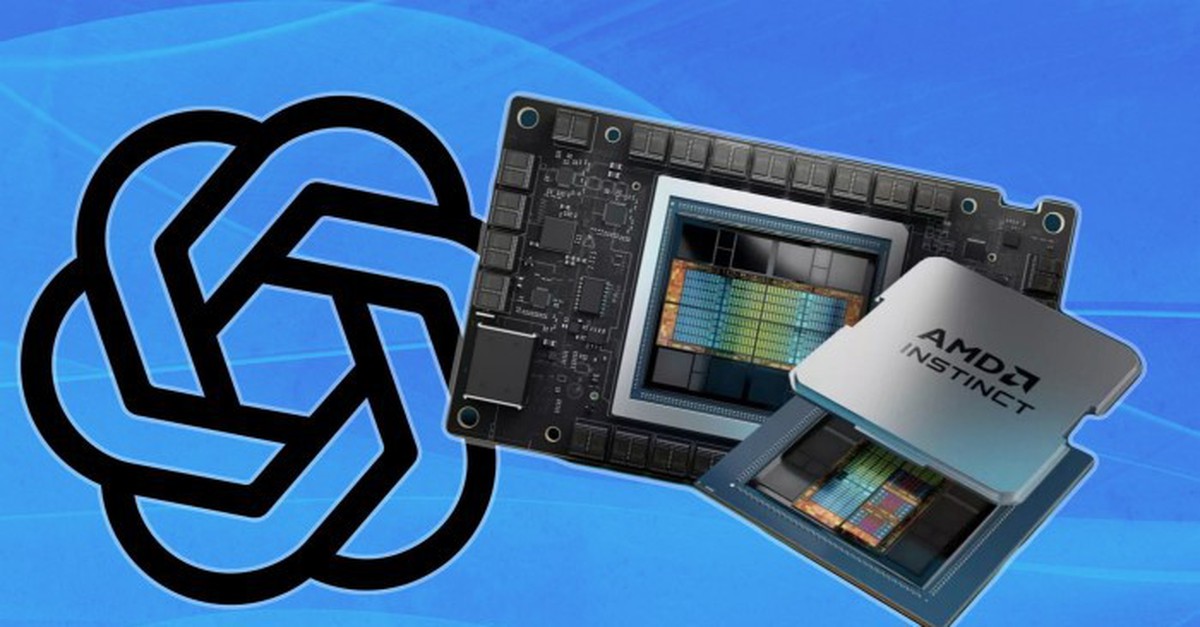OpenAI – AMD’s “Blockbuster” Deal: The Largest Chip Procurement in History Elevates the AI Race to a New Level

In a move that has sent shockwaves through the global tech market, OpenAI, the pioneer in artificial intelligence, and AMD (Advanced Micro Devices), the semiconductor giant, have announced a colossal strategic partnership. With an estimated total value exceeding $60 billion over the next five years, this is not just a simple chip purchasing contract but an event poised to reshape the power structure in the race to develop AI.
This announcement comes just a month after AMD’s main rival, Nvidia, announced a strategic collaboration with Intel, highlighting the unprecedented intensity of competition in the chip and AI industries. The OpenAI–AMD deal not only addresses OpenAI’s critical “thirst for computing power” but also delivers a resounding victory for AMD CEO, Lisa Su, in her effort to challenge Nvidia’s absolute dominance in the AI chip market.
I. Deal Details: The “Tens of Billions” and the Power of Equity
1. The Historic Chip Order and Cash Flow
According to the announcement, OpenAI has committed to purchasing AMD chips equivalent to 6 gigawatts (GW) of computing capacity. This is an immense figure, underscoring the scale of the infrastructure OpenAI is building. The procurement will begin with AMD’s next-generation AI chip line, the MI450, expected to launch next year.
AMD CEO, Lisa Su, revealed to the WSJ that this deal is projected to generate tens of billions of dollars in revenue for AMD over the next five years. While the specific value was not disclosed by either party, AMD emphasized that each gigawatt of capacity is worth tens of billions of dollars, thus placing the total contract value at over $60 billion. This makes the agreement one of the largest technology component purchasing contracts in history.
OpenAI will execute this procurement in two ways: directly with AMD or through major cloud service providers. This strategy allows OpenAI flexibility in infrastructure deployment and the ability to leverage existing cloud services.
2. Strategic Stock Warrants
The most notable and long-term strategic aspect of the agreement is that OpenAI will receive warrants to purchase up to 160 million shares of AMD stock, which equates to 10% equity in the company, at a symbolic price of just $0.01 per share.
These warrants will be granted in stages and are contingent upon OpenAI meeting agreed-upon deployment milestones, demonstrating a strong bilateral commitment. In exchange for massive capital for AMD, OpenAI not only secures a stable chip supply but also gains a strategic stake in the future of the key chip manufacturer. This is a unique supply assurance and interest-alignment mechanism, rarely seen in conventional commercial agreements.
II. The “Thirst” for Compute Power: The Context of the Deal
1. The “Hyper-Scale” Computing Needs of Modern AI
This agreement is the clearest evidence yet of the compute power hunger escalating exponentially in the AI industry. Large Language Models (LLMs) and increasingly complex multimodal AI systems require thousands, even tens of thousands, of specialized chips (GPUs or AI Accelerators) working in parallel for both training and inference operations.
According to OpenAI CEO, Sam Altman, the current challenge is incredibly difficult: “It is hard to overstate the level of challenge right now… We want everything to go fast, but this process takes time.” This demand stems not only from training next-generation models with the potential to rival or surpass human capabilities (AGI – Artificial General Intelligence) but also from handling the massive inference workloads for the hundreds of millions of users utilizing ChatGPT and other OpenAI products.
OpenAI’s choice to use AMD chips, especially for inference tasks, is a sound strategy. AMD’s MI series chips are designed to compete directly with Nvidia’s A100/H100 line, and diversifying the supply chain is essential to reduce reliance on a single vendor (currently Nvidia) and to control costs amidst continuously rising AI chip prices.
2. The Role of NVIDIA and the Pressure to Diversify
Before this agreement, the AI chip market was almost entirely controlled by Nvidia, which commands over 90% of the market share due to its superior CUDA architecture and robust software ecosystem. This dominance created significant pressure on OpenAI and other AI companies.
Previously, on September 22, Nvidia announced a plan to invest $100 billion in OpenAI, reportedly to deploy 10-gigawatt systems for next-generation AI infrastructure. Sources indicated that Nvidia would purchase non-voting equity, and OpenAI would use this capital to buy Nvidia chips. This suggests that OpenAI is pursuing an ambitious, multi-faceted “betting” strategy, simultaneously receiving investment and chips from Nvidia, while also signing a hyper-scale chip purchase contract and granting strategic equity to AMD.
This strategy helps OpenAI:
- Secure Supply: Mitigate the risk of chip shortages due to reliance on one vendor.
- Increase Competition: Create leverage for better price negotiation with both Nvidia and AMD.
- Leverage Technology: Capitalize on AMD’s strengths in large-scale inference tasks.
III. Market Impact: AMD’s Counter-Attack
1. A Major Victory for AMD and the ROCm Ecosystem
This deal is hailed as a major, watershed victory for AMD.
For a long time, AMD faced difficulties penetrating the AI chip market due to the barrier of Nvidia’s CUDA software ecosystem. With this contract, AMD not only secures massive revenue for years but also gains deep technical collaboration with the world’s leading AI company.
OpenAI’s commitment to using AMD chips on a 6 GW scale will compel OpenAI and its partners to invest significantly in optimizing and developing software for AMD’s ROCm (Radeon Open Compute Platform). OpenAI’s involvement will strongly accelerate the development of the ROCm ecosystem, making it more competitive with CUDA, thereby paving the way for AMD to make deeper inroads into other AI companies.
CEO Lisa Su affirmed that this project will “take AI compute capacity to a massive scale,” signaling AMD’s readiness to become a major force in the AI chip race.
2. Restructuring the Competitive Landscape
The OpenAI–AMD deal comes right after Nvidia and Intel announced their partnership to develop the x86 RTX system processor integrating Nvidia graphics for personal computers, and a customized x86 data center processor for Nvidia.
This confirms that the AI chip war has moved beyond the scope of individual products. Instead, it is a war of strategic alliances, software ecosystems, and supply structure.
- AMD – OpenAI: A new strategic alliance focused on data center AI chips and equity power.
- Nvidia – Intel: An alliance solidifying positions in the personal computer segment and seeking to integrate traditional x86 chips with advanced AI chips.
The market landscape is no longer one-sided, where Nvidia reigns supreme, but is gradually shifting towards a “three-legged stool” dynamic with fierce competition among the three giants.
IV. Strategic Vision: The Future of AI Infrastructure
This colossal agreement signals a fundamental change in how AI companies approach infrastructure development.
1. The “Megascale” and “AI Factory” Trend
6 gigawatts of chip capacity is no longer a typical data center; it is a “megascale AI Factory.” For comparison, a standard data center might only require a few dozen megawatts. The 6 GW scale represents OpenAI’s vision for a future where AI models require an unprecedented amount of power and compute capacity to sustain development and expand global services.
2. Deeper Semiconductor and AI Collaboration
The exchange of strategic equity indicates that the relationship between chip companies and AI companies is no longer just customer-supplier. It is a strategic symbiosis, where the success of AMD’s chips is intrinsically linked to the success of the AI models developed by OpenAI. This could establish a new business model, where pioneering AI companies leverage their model development prowess to acquire strategic equity and secure the supply of core technology.
V. Conclusion
The over $60 billion agreement between OpenAI and AMD is a historic milestone, reflecting the rapid and intense change within the technology industry. It proves that AI chip supply has become a strategic national asset, and AI companies are willing to spend unprecedented sums and grant equity to secure the infrastructure for the future.
For OpenAI, this is a bold step to diversify risk, control costs, and secure immense computing resources for the realization of its AGI ambition. For AMD, it is a golden opportunity to break the monopoly, solidify the ROCm ecosystem, and establish itself as Nvidia’s most formidable challenger.
The AI race is no longer just about algorithms or data; it has become a war of kilowatts and teraFLOPS (tera Floating-point Operations Per Second). This agreement is merely the opening chapter for a new era of massive-scale technological alliances, where the lines between chip manufacturer and application developer continue to blur.













